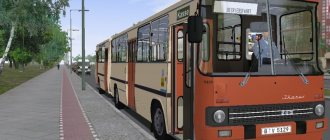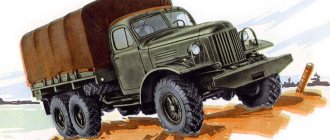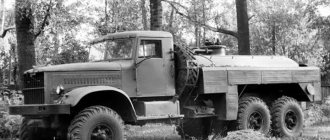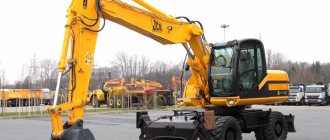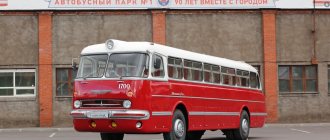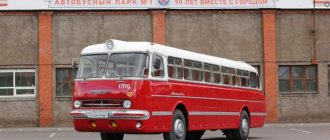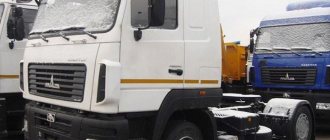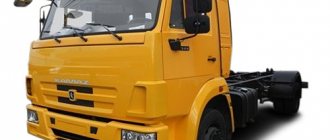The MAZ-538 car is unique; This is a two-axle wheeled heavy tractor with all-wheel drive. It is used for transporting and operating various types of attachments with passive working elements (PKT, BKT). Back in July 1954, in pursuance of a resolution of the USSR Council of Ministers, a separate design bureau was created by order of the director of the plant in Minsk. The main task of the group led by B. L. Shaposhnik was the development of multi-axle heavy tractors with all drive wheels. This date can be called the starting point, although the design bureau began its own secret production only in 1959.
History of creation
The starting model in this project was the MAZ car under the symbol 528. It resembled a tractor and became the progenitor of the wheel series number 538. The heavy vehicle with a 4x4 wheel arrangement took root for a long time and gained popularity in the units of the USSR Armed Forces.
After the release of the order of the Engineering Directorate of the Ministry of Defense, the development of tractors began at SKB-1. The project was headed by V. E. Chvyalev. Particular attention was paid to the ability of the equipment to work with various replaceable attachments, additionally providing towing of trailers. The first tests of two copies with bulldozer equipment took place in 1963 near Grodno. MAZ vehicles passed the test with flying colors, after which they passed additional technical exams and were then recommended for serial production. During the same period, the relevant documentation was transferred to Kurgan.
Adoption
In 1964, the MAZ-538 was put into service with the serial designation IKT-S (engineering medium tractor with wheels). Its industrial development began immediately. The Kurgan prototypes were no different from their Minsk counterparts. They soon became the basis for a whole line of self-propelled bulldozers and road construction equipment, including tracklayers and trenchers.
A diesel power plant was installed in the front part of the spar frame in a riveted-welded configuration. The four-stroke tank engine D 12A-375A had a power of 375 horsepower and was combined with a hydromechanical transmission and a lockable transformer, a three-mode gearbox, and a transfer case with the ability to deactivate the front steering axle.
Principle of operation
Torque is transmitted using an additional gearbox through a pair of hydraulic pumps that drive the power steering. In addition, four categories of attachment parts are involved.
The MAZ-538 winch was driven by taking power from the box. The transmission unit also has a reverse device, which is responsible for moving in the same range of speed and force in the forward and rear directions, without turning.
As a rule, one driver-mechanic controlled the operation of all elements of the tractor. He could use two adjustable chairs, which were placed close to each other and faced in different directions. An adjustable steering wheel, a pair of instrument panels, and a two-way instrument layout system also helped in the work. Elements were placed in the rear and front parts of a paired all-metal cabin with all-round visibility.
MAZ/KZKT-538 family (1960 – 1993)
Using the experience of creating and testing the MAZ-528 and MAZ-532 vehicles in 1960, Minsk SKB-1 completed the design and assembly of a prototype of a more powerful universal short-wheelbase tractor MAZ-538 (4x4), which was destined for a long life and a relatively wide distribution in Soviet army. On instructions from the Engineering Directorate of the USSR Ministry of Defense, it was developed in the SKB-1 engineering tractor design bureau under the leadership of V. E. Chvyalev and was intended for assembly with various replaceable mounted working parts and towing trailer systems. In 1963, near the Belarusian city of Grodno, under the guidance of specialists from the 15th Central Research Institute of the Ministry of Defense, the first two vehicles with simple bulldozer equipment almost flawlessly passed a cycle of state tests and received a recommendation for serial production and adoption. In the same year, all documentation for the MAZ-538 was transferred to Kurgan. In 1964, the vehicle was put into service under the designation IKT-S - a medium engineering wheeled tractor, and at the same time, KZKT began to master its industrial production. The first Kurgan vehicles were no different from the Minsk prototypes and also bore the MAZ-538 markings. Over time, they served as the basis for a whole series of self-propelled engineering earth-moving and road-building machines - a bulldozer, a track-laying machine and a trencher.
In the front part of the riveted-welded spar frame of the MAZ-538 tractor, a tank-type four-stroke diesel engine D12A-375 V12, adjusted to a power of 375 hp, and a hydromechanical transmission with a locking torque converter, a planetary 3-speed gearbox and a transfer case with front steering axle disconnect mechanism. Through an additional gearbox, torque was supplied to two hydraulic pumps, which drove the hydraulic boosters of the redundant steering and up to four groups of actuators of attachments. The winch was driven from the power take-off. The transmission also had a reversing device, which made it possible to move with the same traction forces and speeds in the forward and rear directions without turning. Usually, one driver-mechanic controlled the tractor when moving forward or backward and the rear-mounted working equipment. It had two adjustable seats located next to each other, but facing different directions, as well as an adjustable steering wheel, two instrument panels and two-way controls located in the front and rear of the 2-door all-metal cockpit with all-round visibility. It was equipped with non-folding two-section front and rear windows with windshield wipers, electric heating and sun visors, and the door windows were folding. Its kit included a heater from the engine cooling system and covers for unused controls, and in a special sealed version - a filter-ventilation unit that created excess internal pressure. Another original design feature was the front equalizer suspension on wishbones with hydropneumatic elastic elements, but the rear wheels were rigidly mounted on the frame. The braking system was dual-circuit pneumohydraulic, all wheels were equipped with planetary gearboxes. The tractor package included shielded 24-volt electrical equipment, two fuel tanks with a capacity of 240 liters, front and rear couplings and four standard spotlights on the cab (two in each direction).
375-horsepower engineering tractor MAZ-538 with a dual control system. 1963
The MAZ-538 wheelbase was 3000 mm, track - 2520 mm, overall dimensions - 5870x3120x3100 mm, ground clearance - 480 mm. Curb weight - 16.5 tons, total weight with equipment - up to 19.5 tons. On the highway, the car reached a speed of 45 km/h, could overcome slopes up to 30?, side roll of 25? and fords with a depth of 1.2 m. Average fuel consumption was at the level of 100 liters per 100 km, the cruising range in different conditions and when performing various operations was in the range of 500 - 800 km.
Already in 1965, the first long-wheelbase version of the MAZ-538 was developed in Kurgan. It was an engineering tractor KZKT-538DP with a wheelbase increased by 1.2 m (up to 4200 mm), which made it possible to equip it with larger and more powerful equipment with passive working parts mounted on the front and rear linkages. Its curb weight increased to 18.0 tons, length to 6980 mm, fuel consumption to 105 liters per 100 km. Apart from the partial rearrangement of the auxiliary equipment, the general design and basic parameters of the machine have not changed, but when simultaneously working with mounted units of the opposite location, an operator was included in the crew. In the early 1980s, a second version of the 538DK appeared with an additional power take-off and cardan shafts to drive the active working parts of the TMK-2 trench machine, mounted in the rear of the vehicle frame. A hydraulic creeper was additionally included in its transmission for stepless control of operating speed within the range from 0.25 to 45 km/h. A number of vehicles also had a sealed cabin and a backup pneumatic engine starting system installed. An attempt to create our own basic two-axle tractor with a 525-horsepower version of the D-12 engine was unsuccessful. Serial assembly of 538 series tractors continued at KZKT until the early 1990s - for almost 40 years.
Long-wheelbase chassis KZKT-538DP for carrying passive working equipment (here – PKT-2). 1967
About the workplace
It was equipped with a two-section windshield and rear glass of a non-removable type (with windshield wipers). The cabin also had electric heating, visors to protect from sunlight, and folding glass door elements. To protect parts, covers are provided to cover unused controls. The cabin was heated from the engine cooling system; a filtration unit was located in a special sealed compartment to ensure the creation of excessive internal pressure.
Another design feature of the tractor is the type of suspension. This unit is balanced on wishbones, equipped with hydropneumatic elastic parts, while the rear wheels are rigidly fixed to the frame. The dual-circuit configuration brakes had planetary gearboxes on all axles and a pneumohydraulic system.
Other technical characteristics of MAZ-538
Below are the main parameters of the tractor:
- Dimensions – 5.87/3.12/3.1 m.
- Curb/full weight – 16.5/19.5 tons.
- Ground clearance – 48 cm.
- Wheelbase – 3.0 m.
- Electrical part – 24-volt shielded equipment.
- Additional equipment includes four standard spotlights in the cab, front and rear coupling devices.
The speed of the USSR vehicle in question on the highway reached 45 km/h, steep climbs could be overcome up to 30 degrees, and fords were up to 1.2 meters deep. Average fuel consumption was about 100 l/100 km, range was from 500 to 800 km, depending on operational features. Fuel was placed in a pair of tanks with a capacity of 240 liters.
MAZ » 538
Using the accumulated experience in creating and testing the MAZ-528 and MAZ-532 tractors, in 1960 the Minsk SKB-1 developed an even heavier and more powerful MAZ-538 (4x4) tractor, which was destined to have a long life and a relatively wide distribution in the Soviet Army. In 1963, specialists from the Belarusian 15th Central Research Institute of the Ministry of Defense assembled the first two vehicles with simple bulldozer equipment, which completed a cycle of state tests with virtually no comments and received a recommendation for serial production and adoption. In the same year, all documentation for the MAZ-538 was transferred to Kurgan. In 1964, the vehicle was put into service under the designation IKT-S - a medium engineering wheeled tractor, and at the same time, KZKT began to master its industrial production. The first Kurgan vehicles were no different from the Minsk prototypes and also bore the MAZ-538 markings. Over time, based on them, a whole series of self-propelled engineering earth-moving and road-building machines was created - a bulldozer, a track-laying machine and a trencher.
A tank-type four-stroke diesel engine D12A-375 V12 with a power of 375 hp, and a hydromechanical transmission with a locking torque converter, a planetary 3-speed gearbox and a transfer case with a front steering axle disconnect mechanism were installed in the front part of the tractor. Through an additional gearbox, torque was supplied to two hydraulic pumps, which drove the hydraulic boosters of the redundant steering and up to four groups of actuators of attachments. The winch was driven from the power take-off. The transmission also had a reversing device, which made it possible to move with the same traction forces and speeds in the forward and rear directions without turning.
To drive the MAZ-538 tractor, only one driver-mechanic was enough.
It had two adjustable seats located next to each other, but facing different directions, as well as an adjustable steering wheel, two instrument panels and two-way controls located in the front and rear of the 2-door all-metal cockpit with all-round visibility. Another original design feature was the front equalizer suspension on wishbones with hydropneumatic elastic elements, but the rear wheels were rigidly mounted on the frame. The braking system was dual-circuit pneumohydraulic, all wheels were equipped with planetary gearboxes. The tractor package included shielded 24-volt electrical equipment, two fuel tanks with a capacity of 240 liters, front and rear couplings and four standard spotlights on the cab (two in each direction). The MAZ-538 wheelbase was 3000 mm, track - 2520 mm, overall dimensions - 5870x3120x3100 mm, ground clearance - 480 mm. Curb weight - 16.5 tons, total weight with equipment - up to 19.5 tons. On the highway, the car reached a speed of 45 km/h, could overcome steep slopes of up to 30º, a side roll of 25º and fords with a depth of 1.2 m. Average fuel consumption was at the level of 100 liters per 100 km, the power reserve in different conditions and when performing various operations was within the range of 500 - 800 km. Serial assembly of 538 series tractors continued at KZKT until the early 1990s - for almost 40 years.
Modifications
In 1965, Kurgan engineers developed an extended version of the MAZ-538. It was an engineering tractor with an extended wheelbase (up to 4.2 m) of the KZKT-538 DP type. This design feature made it possible to equip the equipment with more powerful equipment installed on the front and rear linkages.
The curb weight of the vehicle increased to 18 tons, length - to 6.98 m. The main parameters and general design, including the type of gearbox, remained unchanged. Minor work was carried out to reconstruct the layout of auxiliary devices, and another operator was included in the crew to service mounted units of opposite placement.
In the early 80s, the second version 538DK appeared. In this version, the developers have provided an additional power take-off unit and cardan shafts that serve to activate the working parts of a TMK-2 type trench machine installed at the rear of the equipment.
A hydraulic speed reducer was included in the transmission unit, making it possible to adjust the operating speed within the range of 0.25-45 km/h. Some modifications received a pressurized cabin and a repeating pneumatic system for starting the power plant. Attempts were made to create our own two-axle tractor with a 525 horsepower engine (type D-12), but they were unsuccessful. Serial production of models of the 538 series at KZKT lasted almost 40 years (until the early 90s).
Dig, build, tow: wheeled engineering vehicles of the Soviet army
The main developer of such equipment was again the Minsk SKB-1. His first military vehicle, born in November 1955, was the experienced two-axle tractor MAZ-528. In the absence of anything else, its design was based on the general concept of the first Soviet 25-ton mining dump truck MAZ-525, created in 1950 under the leadership of B. L. Shaposhnik, at that time the chief designer of the Minsk Automobile Plant.
Experienced engineering rear-engine all-wheel drive tractor MAZ-528
MAZ-528
(Photos from the MZKT archive)
This little-known military tractor received a number of units from the YaAZ-210 truck and a modified cabin from the MAZ-200, but was deprived of a special suspension and had a rear-mounted engine compartment. It contained a YAZ-206 two-stroke diesel engine with a power of 165 hp, working with a five-speed gearbox, a two-stage transfer case and an additional power take-off for a hydraulic pump and winch. The reverse mechanism in the transmission allowed the car to move at ten speeds in the forward and rear directions without turning. The role of the suspension was played by single wheels with 28-inch low-pressure tires.
165-horsepower MAZ-528 tractor-trailer with a direct front blade
Factory tests of the MAZ-528 chassis vehicle on off-road
Initially, the MAZ-528 was designed to work with mounted bulldozer equipment and as a tractor-pusher for heavy equipment. To improve traction and traction qualities, it was equipped with a 2.5-ton ballast, together with which the vehicle’s weight exceeded 18 tons, allowing it to tow low-load tank trailers.
MoAZ-542
In the 1960s, a brief and little-known page in the history of the Mogilev Automobile Plant (MoAZ) was written by the development of the promising dual-purpose tractor MoAZ-542. In its rear-engine layout and appearance, it was almost no different from the MAZ-528, but in design it was unified with the experienced single-axle tractor MoAZ-546. It used an experienced 240-horsepower YaMZ-238 diesel engine, a four-speed gearbox and a traditional spring suspension, but instead of 28-inch ones, more compact tires measuring 26.50–25 were installed. The reversible transmission ensured stable operating speeds ranging from 0.2 to 40 km/h in both directions.
| A prototype of the 240-horsepower MoAZ-542 tractor (from the archives of the Scientific Research Center AT) and the D-581 wheeled bulldozer on a modernized MoAZ-542 chassis | |
Articles / History Two-wheeled soldiers: secret single-axle tractors of the Soviet Army Despite the purely peaceful profession of the original single-axle tractor vehicles for work in large-scale civil construction, they were secretly in service with the Strategic Missile Forces... 69001 3 32 02/03/2017
In 1964, the MoAZ-542 chassis passed acceptance tests at 21 Research Institutes. Then various companies began to install equipment for loaders and snow blowers on it, but they were not successful. As for the military use of the MoAZ-542, by that time a more advanced and efficient version of the MAZ-538 had already gone into production, and MoAZ’s capabilities were not enough to organize serial production of its own vehicle.
MAZ/KZKT-538 family
Having gained experience in the development and trial operation of the first one- and two-axle tractors, in 1960 the Minsk SKB-1 completed the design and assembly of prototypes of a more powerful and practical two-axle tractor MAZ-538 of the engineering forces for towing heavy systems and mounting various working devices.
On instructions from the Engineering Directorate of the USSR Ministry of Defense, it was designed in the design bureau of engineering tractors at SKB-1 under the leadership of Vladimir Efimovich Chvyalev, the future designer of missile chassis. This vehicle was destined for a long life and fairly widespread use in the Soviet Army, where it was in service with engineering and combat engineer units, and in battalions of motorized rifle and tank divisions.
In 1964, the MAZ-538, which successfully completed state tests, was put into service under the designation IKT-S - a medium engineering wheeled tractor. A year earlier, all documentation for it was transferred to the Kurgan Wheel Tractor Plant (KZKT) for industrial production.
Engineering tractor MAZ-538 (IKT-S) for installation of working equipment (from the MZKT archive)
A 375-horsepower D12A V12 tank diesel engine and a hydromechanical transmission with a planetary gearbox were mounted in the front part of the welded spar frame of the MAZ-538. From it, torque was supplied to the hydraulic pump and power take-off shafts to drive the winch and actuators, and the reversing device allowed the machine to move at the same speeds and traction forces in both directions. The original front independent suspension combined wishbones with hydropneumatic elastic elements, but the rear wheels were rigidly mounted on the frame.
MAZ-538 tractor with front steered wheels and rear blade (photo by the author)
375-horsepower MAZ-538 tractor with dual control system (photo by the author)
To control a heavy vehicle with only one driver-mechanic, an elevated, compact all-metal cabin with all-round visibility was created. It was equipped with two-way controls, an adjustable steering wheel, two instrument panels and two seats located next to each other, but facing different directions.
Long-wheelbase chassis KZKT-538DP for installation of passive equipment
When Minsk tractors were modernized in Kurgan, their factory markings were changed to KZKT. The first of these, in 1965, was the long-wheelbase version KZKT-538DP without a power take-off. Its main purpose was to work with passive working bodies that were not driven by the car engine. The second KZKT-538DK chassis with a sealed cabin and power take-off was used for mounting active earth-moving units, and a hydraulic creeper allowed them to move at operating speeds from 0.25 to 45 km/h.
Extended chassis KZKT-538DP with rear linkage of a bulldozer blade (photo by the author)
Special chassis KZKT-538DK with excavator equipment (photo by K. Dunaev)
Engineering equipment on the MAZ/KZKT-538 chassis
With the start of production of MAZ-538 vehicles manufactured in Minsk and Kurgan, a whole range of mounted and trailed work equipment was developed specifically for them. The first of them were simple engineering vehicles with passive mounted working parts - the BKT multi-purpose wheeled bulldozer-tractor and the PKT army track-laying vehicle. Later, the active equipment of the TMK trench machine of the Dmitrov Excavator Plant was mounted on the Kurgan chassis.
Wheeled bulldozer tractor BKT with a direct blade on the MAZ-538 chassis
The basic bulldozer wheeled tractor BKT on the MAZ-538 vehicle was used to tear off various utility lines. Its working body was an ordinary straight bulldozer blade 3.3 meters wide. In one hour, the machine could move up to 100 cubic meters of soil. On the extended version of the KZKT-538DP, a more efficient version of the BKT-RK2 with a winch and a rear ripper was mounted.
Bulldozer-tractor BKT-2 on the KZKT-538DP chassis with a rear straight blade
BKT-RK2 machine with rear ripper and front blade
The PKT serial track-laying wheeled tractor was used to create communication routes for military convoys on the ground and carry out earth-moving work. Unlike the bulldozer, it received a three-section plow blade of variable configuration with hydraulic adjustment of the position of the folding side parts (wings). A steel ski was usually installed in front of it to limit the depth of the blade and unload the hydraulic cylinders of the hitch. Depending on the type of work performed, the width of the cleared passages varied between 3.2-3.8 meters. Within an hour, the machine paved up to 10 kilometers of roadways.
1 / 3
2 / 3
3 / 3
The long-wheelbase KZKT-538DP chassis was used for the modernized PKT-2 track layer, capable of clearing wooded areas of bushes and felling trees with a diameter of up to 25 centimeters.
1 / 2
2 / 2
The main tasks of the TMK-2 trench wheeled vehicle on the KZKT-538DK chassis were to mechanize and accelerate the process of tearing off trenches and communication passages with a depth and width of 1.5 meters. In its rear part, rotary multi-bucket digging equipment was mounted with a throwing device for throwing excavated soil in both directions. An auxiliary straight bulldozer blade from the well-known BTM tracked vehicle was mounted in front. In one hour, the trencher was capable of digging up to 300 meters of trenches.
1 / 4
2 / 4
3 / 4
4 / 4
The assembly of 538 series tractors continued in Kurgan until the early 1990s - for almost 40 years.
Purpose of MAZ-538
Initially, two types of special engineering equipment with passive working elements were created for installation on the rear linkage of a tractor:
- PKT track-laying machine with a plow-type blade of variable configuration.
- Multipurpose bulldozer tractor (BKT) with a standard straight blade.
Subsequently, improved analogues were equipped with more modern attachments, including a trenching machine with a front blade and a rear rotor attachment. Such vehicles in the USSR were adopted by sapper, engineering and tank units. Equipment was supplied to the armies of some socialist countries in limited quantities.
Review of MAZ-538
The heavy two-axle tractor MAZ-538 has become widespread mainly in the engineering troops.
The MAZ-538 is equipped with a twelve-cylinder V-shaped diesel engine D12A-375, similar to that used on the four-axle MAZ-535 tractor. To transmit torque from the engine to the wheels, a hydromechanical transmission is used, consisting of a torque converter, a gearbox, a two-stage transfer case with reverse and two drive axles.
The design of the transfer case allows the car to move both forward and backward at the same high speed (45 km/h). The drive axles have large-diameter wheels with wide-profile constant-pressure tires with a tread pattern of the “oblique non-divided herringbone” type, providing high traction.
The vehicle was mass-produced by the Kurgan Wheel Tractor Plant. During the production process it was modernized, in particular, it received a more powerful D12A-525 engine with 525 hp. The improved version received the designation KZKT-538D.
Various modifications of the MAZ-538 served as the basis for the creation of the PKT, PKT-2, BKT and TMK-2 engineering vehicles.
Tracklayer - the PKT wheeled tractor is used for laying column tracks, leveling and clearing sites, snow removal and other engineering work. A working body (blade), consisting of two halves, is mounted at the rear of the machine. The blade halves can be tilted at an angle of up to 10 degrees in both directions relative to the vertical axis, which allows the machine to be used in various capacities: when the blade halves are installed in a neutral position (perpendicular to the longitudinal axis of the machine), the PKT is used as a bulldozer; when the blade halves are skewed at an angle 10 degrees, but in opposite directions, the machine is used as a grader, in the case of installing the halves of the blade at an angle of 10 degrees. in one direction the car performs the functions of a tracklayer. PKT is capable of laying on average 4 km of column tracks per hour; when excavating pits, its productivity is 70 cubic meters of excavated soil per hour. The additional equipment of the PKT includes a winch with a force of 25 tons, a crane device with a lifting capacity of 2 tons and a boom reach of 7.4 m, and a coupling device.
The BKT wheeled tractor bulldozer is designed for mechanization of various earthworks and can perform site leveling, excavation excavation, backfilling of trenches and similar work. The coupling equipment allows the machine to be used for towing heavy trailers. The working body of the BKT is a bulldozer blade located in the front part of the machine.
The TMK-2 trenching machine is equipped with a rotary working body located at the rear of the vehicle and designed to tear off trenches 1.5 m deep and 0.6 m wide at the bottom. The machine is capable of tearing up to 800 m of trenches per hour. Additionally, TMK-2 is equipped with a bulldozer blade in the front part.
BKT
A multi-purpose bulldozer on a MAZ-538 chassis was used to excavate pits, trenches, communications, clear large territorial areas, and carry out other excavation operations on different types of soil.
The working element of the unit was a straight blade with rear placement (width - 3300 mm). BKT productivity varied from 60 to 100 cubic meters per hour. With a curb weight of 17.6 tons, the equipment was able to operate on slopes of 25 degrees. A modernized bulldozer of the BKT-RK2 type was installed on a modified chassis from KZKT. It was equipped with a front blade, a traction winch, and a rear rotating ripper with five teeth, allowing it to work effectively on the most difficult soils. The productivity limit has increased to 120 cubic meters per hour. Power reserve is about 800 km.
Description
The car sits on four equal-sized wheels with low-pressure tires. The rear wheels are controlled similarly to a forklift. In early models, the bulldozer blade had a characteristic V-shape, which was gradually replaced by a flat one. Later it was decided to install additional equipment on the rear of the machine, such as traction devices, rippers for loosening the soil or large trenching machines. Depending on the version, the car was driven by one or two people.
Power for both the vehicle and its supporting equipment comes from a V-12 D12A-375 diesel engine originally designed for World War II tanks. The 38.8 liter engine produces 375 hp. During production history there were attempts to improve performance with a 525 hp version, which were not tested for unknown reasons and were not pursued. All variants were equipped with all-wheel drive and designed specifically for longevity.
Over time, there was a tendency to make cars larger and heavier. Thus, in 1965, the wheelbase of the KZKT-538DP version (Russian KZKT-538DP) was increased by more than a meter; in later models, the curb weight increased by almost 10 tons. The possible hourly productivity has also been increased. Depending on the design, previous machines were designed to move between 60 and 100 m³ of soil per hour. The latest generation was designed for a capacity of up to 160 m³ per hour.
PCT
The wheeled tractor for laying tracks at the 538th base was used for its intended purpose, as well as in the construction, repair, clearing, grading of roads and for general construction and earthmoving work. Unlike the BKT, this machine was equipped with a plow blade with three sections. The compartments were adjusted using hydraulics; the type of fastening on the middle part was hinged.
A steel limiter in the form of a ski was mounted in front or behind the blade, which made it possible to limit the level of penetration into the ground and unload the hydraulic cylinders of the hitch. The internal technical part, including the type of gearbox (planetary three-stage unit), has remained virtually unchanged. The working width of the working body varied from 3200 to 3800 mm, the maximum productivity was up to 10 kilometers per hour, and for earth-moving operations up to 80 cubic meters. Curb weight – 19.4 tons.
On the basis of 538DP, the design of the improved track-laying PKT-2 was installed, which cleared the area of various vegetation, including stumps and trees with a diameter of up to 250 millimeters. Its maximum productivity reached 160 cubic meters per hour, and its weight increased to 23 tons.
Story
Front view of the same machine (2016) Side view Back
in 1955, a series of prototypes of a heavy wheeled bulldozer was built and tested, which at that time was still called MAZ-528. It is unclear exactly when the designation was changed to MAZ-538 and why this change was made. However, it is known that the cars have been produced since 1964 under the name MAZ-538 in mass production.
Back in 1965, other factories began producing different versions of the car. Unlike the prototypes and first models, this partly happened outside the MAZ plant at the then secret (or even officially non-existent) military enterprises, such as MZKT or KZKT. Various variants were made until the 1990s, often designated by a three-letter combination such as BKT (Russian: БКТ) or PKT (Russian ПКТ) instead of MAZ-538. KT stands for wheeled tractors (Russian: wheeled tractor), the first letter for a specific application depending on the attachment.
Various variants found relatively wide distribution in the Soviet armed forces, as well as in the successor republics. Some examples are now on display in museums or continue to be used for civilian purposes.
TMK-2
Wheeled rotary-type trenching equipment based on the 538DK heavy tractor had a duplicate engine start-up circuit and was intended for tearing out trenches, ditches and communication passages up to one and a half meters deep, with a width of 0.9 to 1.5 m. Multi-bucket excavator equipment with a thrower for throwing out processed soil in two directions it was mounted on a powerful frame in the form of a parallelogram. Additionally, the equipment was equipped with lifting hydraulic cylinders and a chassis power take-off.
Brief characteristics:
- Weight in running order – 27.2 tons.
- Dimensions with equipment – 9.74/3.33/4.17 m.
- The range of performance parameters is from 80 to 400 m/hour.
- The working slope of rise and roll is 12/8 degrees.
- Suspension type - multi-link unit with rigidly fixed rear wheels.
- Average fuel consumption is 50 l/100 km.
- Power reserve – 500 km.
- Transformation from transport state to working position – three minutes.
Technical data
(for basic version)
- Engine: V-12 diesel engine
- Engine type: D12A-375
- Engine capacity: 38.88 l
- Power: 276 kW (375 hp)
- Drive formula: (4×4)
- Fuel consumption: approx. 100 l / 100 km
- Fuel capacity: 2 × 240 l
- Maximum speed: 45 km/h
- Mains voltage: 24 V
Dimensions and weight
- Length: 5870 mm
- Height: 3120 mm
- Width: 3100 mm
- Wheelbase: 3000 mm (later increased to 4200 mm)
- Ground clearance: 480 mm
- Track width: 2520 mm
- Curb weight: 16.5 tons
- Permitted gross weight: up to 19.5 tons.
Let's summarize
Soviet vehicles based on the MAZ-538 heavy tractor are two-axle universal vehicles, designed to operate various types of attachments, as well as tow trailers weighing up to 30 tons. The design features of the car include a wide speed range, the presence of a reverse, an average location of the cabin and partial duplication of control elements. This made it possible to perform the required work both backwards and forwards. Tractors have been actively and effectively used primarily for military needs for several decades.
